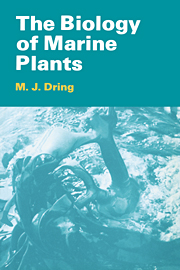Book contents
- Frontmatter
- Contents
- PREFACE
- ACKNOWLEDGEMENTS
- 1 MARINE PLANTS: TAXONOMIC, MORPHOLOGICAL AND ECOLOGICAL CATEGORIES
- 2 THE SEA AS AN ENVIRONMENT FOR PLANT GROWTH
- 3 PHOTOSYNTHESIS IN THE SEA
- 4 GROWTH AND PRODUCTIVITY OF MARINE PLANTS
- 5 MORPHOGENESIS OF MARINE PLANTS
- 6 THE ECOLOGY OF SEAWEEDS: ZONATION AND SUCCESSION
- 7 GEOGRAPHICAL DISTRIBUTION OF MARINE PLANTS
- 8 USES AND USAGE OF MARINE PLANTS
- 9 BACTERIA AND FUNGI IN THE SEA
- REFERENCES
- INDEX
1 - MARINE PLANTS: TAXONOMIC, MORPHOLOGICAL AND ECOLOGICAL CATEGORIES
Published online by Cambridge University Press: 02 February 2010
- Frontmatter
- Contents
- PREFACE
- ACKNOWLEDGEMENTS
- 1 MARINE PLANTS: TAXONOMIC, MORPHOLOGICAL AND ECOLOGICAL CATEGORIES
- 2 THE SEA AS AN ENVIRONMENT FOR PLANT GROWTH
- 3 PHOTOSYNTHESIS IN THE SEA
- 4 GROWTH AND PRODUCTIVITY OF MARINE PLANTS
- 5 MORPHOGENESIS OF MARINE PLANTS
- 6 THE ECOLOGY OF SEAWEEDS: ZONATION AND SUCCESSION
- 7 GEOGRAPHICAL DISTRIBUTION OF MARINE PLANTS
- 8 USES AND USAGE OF MARINE PLANTS
- 9 BACTERIA AND FUNGI IN THE SEA
- REFERENCES
- INDEX
Summary
It is generally accepted that life on earth began in the sea and that, until about 450 million years ago, all plants were marine plants. The next 400 million years witnessed the evolution of the land flora, including bryophytes, pteridophytes, gymnosperms and flowering plants. The story of this invasion of the land is usually told in terms of the developments in morphology and reproduction that made plants less and less dependent on the presence of free water, but one aspect that is often overlooked is that, in this process, plants lost their ability to live in sea water. Throughout the modern bryophytes, pteridophytes and gymnosperms, there is not a single marine species and, in the angiosperms, which have evolved more than 200 000 species adapted to almost every terrestrial and freshwater habitat, there is only one small group of seagrasses (about 50 species world-wide) which can be described as truly marine. Even the fungi are poorly represented in the sea, since marine species account for only 1% of the total fungal flora. Thus the sea remains — as it must have been in pre-Devonian times — the province of the algae, and today about 90% of all the species of marine plants belong to one or other of the groups of algae (Table 1.1).
TAXONOMIC CLASSIFICATION
Many of these algal groups are now themselves represented mainly by freshwater species, and only two groups — the brown (Phaeophyta) and the red algae (Rhodophyta) which predominate among attached marine plants — remain almost exclusively marine.
- Type
- Chapter
- Information
- The Biology of Marine Plants , pp. 1 - 12Publisher: Cambridge University PressPrint publication year: 1991



